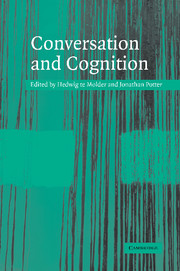Book contents
- Frontmatter
- Contents
- List of contributors
- Acknowledgements
- Transcription conventions
- 1 Talking cognition: mapping and making the terrain
- Part I The interface between cognition and action
- Part II Cognition in action
- 7 Is confusion a state of mind?
- 8 Cognition in discourse
- 9 From process to practice: language, interaction and ‘flashbulb’ memories
- 10 ‘My memory has been shredded’: a non-cognitivist investigation of ‘mental’ phenomena
- 11 Discursive psychology, mental states and descriptions
- References
- Index
7 - Is confusion a state of mind?
Published online by Cambridge University Press: 22 September 2009
- Frontmatter
- Contents
- List of contributors
- Acknowledgements
- Transcription conventions
- 1 Talking cognition: mapping and making the terrain
- Part I The interface between cognition and action
- Part II Cognition in action
- 7 Is confusion a state of mind?
- 8 Cognition in discourse
- 9 From process to practice: language, interaction and ‘flashbulb’ memories
- 10 ‘My memory has been shredded’: a non-cognitivist investigation of ‘mental’ phenomena
- 11 Discursive psychology, mental states and descriptions
- References
- Index
Summary
Introduction
First, some preliminaries, to clear the decks. There are, of course, good reasons for detaching the study of interaction from that of cognition and treating the interaction order as an autonomous field of conduct. Most radically, some have rejected the dualism between mind and action, proposing for instance that it makes no sense to regard action as the embodiment or manifestation of some putative prior mental state (Melden, 1961; Ryle, 1963; Coulter, 1979). However, those who study conversation have what are perhaps less radical reasons for rejecting a cognitive approach to conversational action. First, we cannot know from speakers' behaviour in conversation, that is from what is said, what they were thinking or feeling as they spoke. Their mental states are opaque in their verbal conduct. Second, the organization of conduct in conversation and talk-in-interaction generally, can be shown to be systematically socially organized independently of the predispositions – and hence personality and other mental constructs – of the individuals who happen to participate in any particular interaction.
The opacity of cognition in conversational (inter)-action and the autonomy of the social organization of conduct (and the sequences associated with conduct) in talk-in-interaction, taken in combination with one another, suggest that the practices of verbal conduct are independent of the cognitive states of individual participants. Some brief examples may help to illustrate this, and begin to show something of the complexity of connecting action and mind. Consider the construction of turns in which speakers decline invitations, as in this instance.
- Type
- Chapter
- Information
- Conversation and Cognition , pp. 161 - 183Publisher: Cambridge University PressPrint publication year: 2005
- 39
- Cited by



